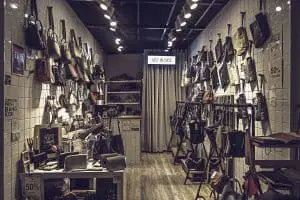Introduction
When defining a strategy for your fashion brand, a competitor’s analysis is a good starting point in terms of identifying niches of untapped value. In other posts, we addressed the criteria to segment customers both from a demographic and behavioral perspective, but we are now taking a different look, by comparing and contrasting firms by looking at their strategic decisions as well as their organizational structure.
In this post, we are going to discuss what types of criteria can be identified in order to segment the firms operating in the fashion industry and compare them with each other. These are the main criteria we are going to address:
- The Breadth of Product Portfolio
- Fashion Content
- International Presence
- Company size, vertical integration, and distribution
- Conclusions
1. The Breadth of Product Portfolio
Traditionally fashion firms would identify a brand strategy oriented towards positioning their products according to the “Fashion Pyramid” which is split into 5 levels (haute couture, ready-to-wear, diffusion, bridge, mass). According to each marketprice tier of the pyramid, companies would manage their supply chain, in order to align their brand with the expectations of the market. For each positioning statement, a brand would manage its production pipeline to create the right balance between quality and quantity.
This model, however, is not surpassed because in reality what companies are doing is focusing more on the intangible values of their brand as opposed to building assets into the company. A high-value brand can be monetized in a much wider set of scenarios, amplifying the types of products that can carry the brand and the price point of each item. Let’s see them in detail:
- Horizontal growth, a wider product range. A high-quality brand can decide to put their logo to luxury experiences, rather than limiting themselves to luxury garments. As the luxury market grows, it has started to become more intangible. A fashion firm can decide to use its brands in association with lifestyle products, events, hospitality, travel as much as with clothing in order to expand on its product offer. As the goal of brands is to acquire and retain customers, providing an expanded brand environment can help to keep your customers engaged and connected. We address the growth of the luxury market and its trends in this post.
- Vertical growth, a deeper product range. At the same time, if your high-value brand is only operating at the haute couture or prét-a-porter tiers of the pyramid you are missing out on the opportunity to build a following of users at lower tiers of the market. There are many ways in which a fashion firm can use its brand to access lower-tier product categories, for instance using masstige products, a category of products represent mass-prestige, for fragrances, cosmetics, and beauty. However, masstige is still a limited approach to this topic, as many brands decide to conjugate their product offer to each price segment. An example can be provided by Armani and his collection portfolio comprised of Giorgio Armani Privè (haute couture), Giorgio Armani (prèt-a-porter), Armani Collezioni (second linediffusion), Emporio Armani (bridge), Amani Jeans (lower bridge), Armani Exchange (mass).
However, it has to be noted that for each segment, a fashion firm doubles its product development, its staffing, its operations, etc. This is why, even if the value associated with the products is still mostly drawn from its brand or griffè, at the same time only very large and global companies can afford this ‘all-in’ strategy. This means that start-up companies and new entrants need to start with operating on a niche, before expanding in neighboring segments.
If we look at the price range and to a company’s brand image as a reflection of their positioning onto the fashion pyramid, we have to take into account the fact that the simplified contract between cheapexpensive price points reflects externally to the organization as well as internally.
- Externally. Price points are one of the first elements taken into account by customers who want to acquire a product. Pricing instantly defines your target audience and your target market in terms of benefitscosts associated with the purchase.
- Internally. Creativity in the design of clothing is heavily impacted by the final price, fast-fashion companies for instance, in order to maintain a competitive price will not hire designers but will rely on style offices, which will not really create anything new, if not imitating what is being done by others. Additionally, firms who use this approach will not be likely to develop their brand, as a fast-fashion collection can hardly be recognizable, or have their own DNA.
The contractual tool to manage your brand as it operates in different products, or different industries, is licensing. If you’d like to find out more about this topic, here’s an article for you. If instead you’re looking into more information on the fashion pyramid and the business models of fashion firms here’s an article you might be interested in.
2. Fashion Content
The second factor we are going to address is a firm’s fashion content. This criterion relates to how a company addresses the element of time. Let’s start with a clarification: time in fashion and time in luxury are two radically different things.
- Time in Fashion. Time is fashion is projected towards the future. In a sense, fashion is about change, trends, and fads. A fashionable brand is a brand that is continuously looking for novelties and evolving at every season, collection or mood. Fashion is about embodying the change in society and being at the fringe of taste.
- Time in Luxury. Time in Luxury is the opposite, time is about the past, it’s about heritage, it’s about a narrative that has been told for decades if not centuries. Time in luxury is about staticity, lack of change, about resilience against the passing trends.
According to these two different time-orientations, fashion firms can follow four different paces, the first two are more typical of luxury and heritage brands, the last two are more typical of more fashionable firms, or even fast-fashion retailers.
- Classic
- Updated
- Metropolitan
- Avantgarde
The decisions regarding the fashion content of their production will be related to the international strategy pursued by a company. In this sense, as the fashion content is a cultural relative, finding the right balance of fashionability according to the specific market a firm wishes to enter can provide a competitive edge. More classic lines will fit more general taste and will be easier to export with little – if any – adaptation, more stylish collections will need to be carefully planned if they are to interject the taste and preferences of foreign markets. We’ll discuss this in more detail in the next paragraph.
3. International Presence
An international company will generate revenue in international markets, and according to where most of the revenue will come from, it will change and tailor its growth to the needs of its evolving customer population. As we discussed in the previous section, this will have a lot to do with the fashion content of the collection, or its style and creativity. At the same time, the international presence of a firm will give us a lot of information in terms of how its value chain is managed.
The value chain is a simplified representation of the processes happening within a company, usually, we break down the value chain into four segments: research and development, production, marketing, distribution.
A globalized value chain will be likely to respond to the business logic of a company that is pursuing global expansion and is looking at location advantages in order to find efficient sites where locating production, or countries where to acquire raw materials.
In the past 30 years, companies have been exploiting the financial and cost benefits of a globalized value chain in order to gain higher profit margins by keeping the costs of production low, but this has had a very high impact on the environmental cost of fashion. As a consequence, now many firms are going back to managing a more transparent, and when possible, domestically managed value chain in order to show accountability for their production pipeline. By looking at the way in which firms manage their value chain we’ll also collect important information regarding their size.
4. Company Size, Vertical Integration and Distribution
Last but not least, we can look at the way in which fashion firms manage their operations. Here are some additional criteria to segment fashion firms. By looking at vertical integration, we can look at whether companies manage their value chain through relationships that involve organizations owned by a firm, as opposed to organizations that are bound to the fashion firm through a contractual relationship.
In this sense, we split firms according to their use of outsourcing or insourcing strategies.
- Outsourcing. A company outsourcing the segments of its value chain is looking to create cost efficiencies by finding partners willing to work, under a contractual obligation to provide, manufacturing services and distribution. Research and Marketing are not usually outsourced, as the design of a collection and the promotion of the brand are core activities that need to follow very strict guidelines. As a result, fashion firms hardly ever outsource these components of the value chain.
- Insourcing. Insourcing, or managing some of the value chain operations within the company is a way to ensure that operations are conducted following the most rigorous standards. Haute couture and luxury brands rely on insourcing, or direct supervision to guarantee the TQM (total quality management) of the final product, which is essential in order to add to the price tag the “luxury premium”. This option is more expensive, as it involves a sizeable investment of money upfront, however it does allow to directly oversee each one of the thousands of tasks that bring a product to life.
Another element to take into account is the logic of interaction with the market. We can both have either push or pull systems, and combinations of the two.
- Planned manufacturing. This is the way in which fashion companies usually operate. With planned manufacturing fashion firms only produce a collection (which in the meantime has only been prototyped or sampled) only after orders have been filled. This happens because fashion firms need to scale production according to the actual market request, without burdening themselves with unsold goods. This economic advantage comes at a cost: the TTM (time to market) of the final product will experience some lag, and customers will need to wait longer before accessing the product in stores.
- Fast delivery. In order to offset this lag, the fast delivery model was developed. As a result, fashion companies decide to “bet” on a series of items in the collection in order to minimize wait time on those items which are more likely to be sold. These types of items can include iconic pieces, popular items or new items that a firm wants to test through retail. Of course, there is an underlying issue, which can relate to the fact that some of these items may go unsold.
- Reassortment. In this model instead, a company splits production giving more attention to the feedback received by retailers and their customers. With reassortment, a firm decides to invest in producing those items that have already been sold, and are in demand. In this case, more emphasis is put on the customers, as opposed to the market knowledge of the retailers.
- Fast Fashion. The maximum degree of customer orientation is instead shown by fast fashion companies where 100% of production is based on monitoring as closely as possible the ongoing demands of the public, by producing in short 6-week cycles the items which meet the taste of the customers. The low cost of production allows for a certain degree of hit or miss strategy, however, this approach, heavily based on economies of volume has a detrimental impact on the environment.
An additional element of differentiation pertains to distribution. In the value chain, in fact, we can argue that the last segment, distribution, is one of the most important, if not the most important given that customers may transition their shopping experience from being product-based to being experience-based. Even if the retailwholesale segment is the last mile for the company, is still the first point of connection with customers, and adds a lot of value to the product. Let’s compare the two models or retail and wholesale.
- Retail. Retail is a directly operated point of touch between the brand and the customer. As discussed, fashion retail is becoming more experiential and less physical, so as a result these stores can add value to the purchase by being educational, entertaining, aesthetically engaging or even escapists.
- Wholesale. Through wholesale companies are able to access a network of independent wholesalers that sell a brand within a multi-brand store. This allows a brand to avoid the costs associated with operating a fully owned store and allow it to test markets without excessive investment. At the same time, brands might miss the price premium associated with direct distribution.
Of course, now there are many ways in which retail and wholesale find new combinations of value, like in the case of flagship stores and omnichannel distribution as discussed in this post.
Here are the four most prominent business models in the fashion supply chain:
- Vertically Integrated Luxury Brands. As previously discussed this is the model associated with luxury brands that seek total control over each segment of design, production, marketing, and distribution. Their “promise of consistency” would be hard to keep if they operated through third parties.
- Industrial Brands. These brands seek economies of volume and use the means of industrial production to strike the best balance between the cost of production and the cost of sale. The lower price point allows them to work with processes where a complete obsession for detail might be lacking, but with no actual impact on the final quality.
- Licensing Relationships. These are the models followed by companies that acquired high intangible brand equity and look for monetization through licensing. This model is particularly prominent in masstige, in eyewear, fragrances and beauty products.
- Art Directorship. According to this model, a company relies on the expertise and reputation of a fashion designer in order to create its collection. This can be helpful as it allows firms to take advantage of the high value associated with a designer and attach it to the product created by the firm.
As a result of the complexity of the fashion industry, it’s impossible to find two companies that are exactly alike. As seen in this post, there are so many elements of differentiation that firms will always find some degree of freedom and novelty in the way they are going to grow internationally.
5. Conclusions
As we’ve discussed there a variety of criteria that can be adopted in order to segment firms operating in the fashion industry. With these criteria, we can run a competitor’s analysis and add a strategic interpretation of the simple collection of data. This is very important because markets are never static, and its no use simply taking a snapshot if we can make a time-lapse.
Another use of these criteria is to help entrepreneurs look at some organisational elements in their companies and evaluate what can be done in terms of growing their business. In the creative industries, we often find ourselves navigating uncharted territories, and in this context, our competitors are oftentimes our greatest allies.
If you’re interested in learning more about the Fashion Industry, don’t hesitate to take a look at our course “The Fashion Industry: Explained”. Our in-depth class covers a wide range of topics spanning from understanding fashion customers and markets to developing immersive retail experiences for your customers. Here’s a link to the course, if you use the discount code BLOG20 you can access a 20% discount. Enjoy!







